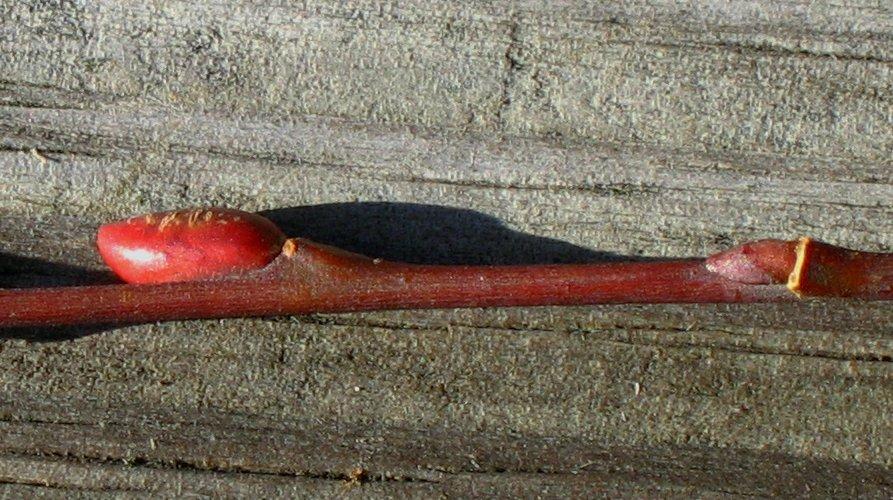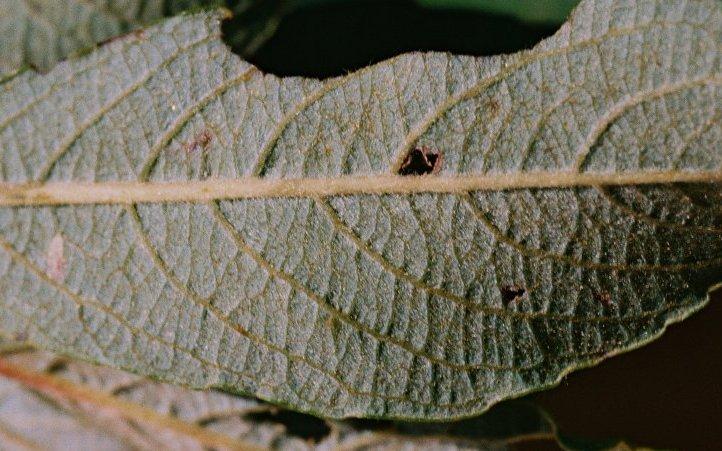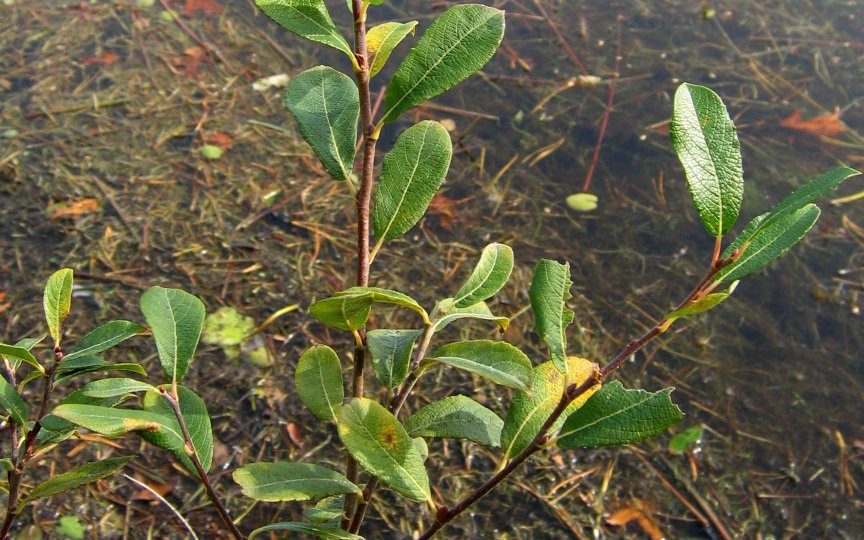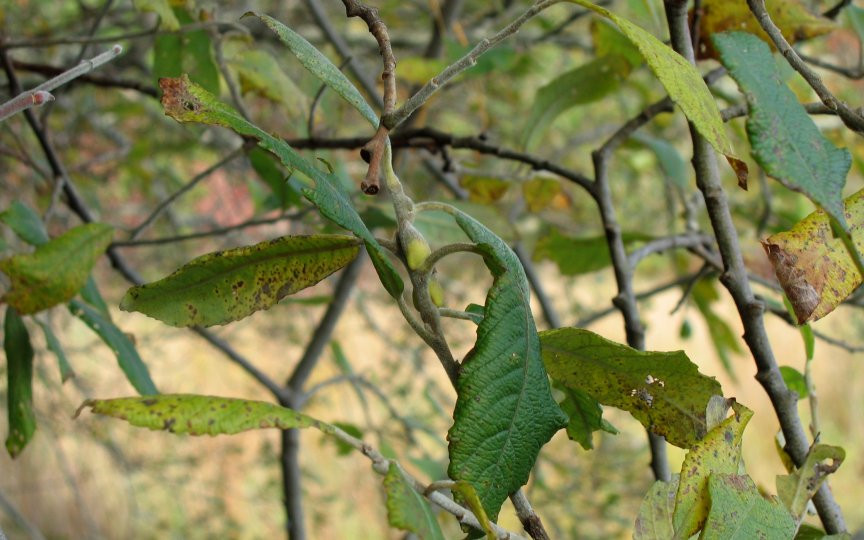

 |
 |
European rusty willow S. atrocinerea in eastern MassachusettsAlexey Zinovjev and Irina Kadis
Rusty willow (S. atrocinerea Brotero) is an Atlantic West-European species that
naturally grows in Britain, France, Belgium, Spain, Portugal, on some
Mediterranean islands, and in North Africa. It belongs to a large section
Vetrix or Cinerella, whose members are difficult for
identification. It has been treated as a subspecies of a continental
Eurasiatic species, gray willow (S. cinerea L.), hence in the literature, S. atrocinerea has been often referred as
S. cinerea ssp. oleifolia (Smith) Macreight or even just
S. cinerea. However, the world
authorities on the genus Salix prefer
to treat rusty willow and gray willow as two different species (Skvortsov
1968, 1999; Argus 1997, 2005). Indeed there is not very much that these
two willows really have in common. Remarkably, phenetic analysis of a
Spanish population of S. atrocinerea
demonstrated that S. atrocinerea
"clusters with S. aurita, S. starkeana and S. bebbiana, not with S. cinerea" (Argus 1997: 76, footnote). Therefore, the treatment
of the two as subspecies of a single species seems not enough justified.
Unless the opposite is proved, we prefer to treat them as two separate
species.
In the US, naturalized S. atrocinerea was first identified by George Argus (1985) as
herbarium specimens from North Carolina, the oldest of which dated back to
1929 and 1939. The second finding occurred a decade later in New York
(Tucker 1996). Tucker discovered an alien-willow infestation and sent his
vouchers to Argus, who identified them with rusty willow previously known
only from North Carolina.
However, the alien willow still remained unknown to the
majority of field workers. Until recent years its expansion on the North
American Atlantic Coast has remained unnoticed, even though it has been
very abundant and in some areas even dominant. Rusty willow has been taken
for native American willows, mostly Bebb's willow (S. bebbiana Sarg.) or pussy willow (S. discolor Muhl.). This situation changed only
when Tom Rawinski (Rawinski 2005) identified the common willow on the New
England coast with the European species and demonstrated its invasive
character. Rawinski addressed the scientific community as well as general
public through a number of newspaper and online publications. Since then,
this willow has been discovered and discussed in all of coastal New
England. The findings triggered a multitude of reports, notes, and
publications (Tucker 2006, 2007; Northeastern Area News Notes February
2006), particularly on the web, including our own, at www.salicicola.com
(2006, 2007) and in the Friends of the Blue Hills Newsletter (Kadis 2007).
In autumn of 2005 we had a chance to make two short field trips in the
Boston area, one with T. Rawinski, the other with G. Argus. Consequently,
we could conclude with more confidence that the most common willow around
Boston is indeed Salix atrocinerea.
Its identity in eastern Massachusetts is now quite obvious.
At the same time, many questions regarding the "invasive willow" remain unresolved.
First of all, not only S. atrocinerea
but also S. cinerea is present within the alien complex.
Yet the latter seems to play a much more modest role.
Another problem is that many
specimens exhibit characters intermediate between S. atrocinerea and the native American willows.
This situation makes one assume that S. atrocinerea has expanded in eastern MA at least partially by
way of producing hybrids with the American willows. While in balanced
ecosystems there exist mechanisms preventing hybridization of closely
related species, these isolation mechanisms may fail when humans promote
species from continent to continent. The fact that the expansion of the
alien willow and/or its hybrids has remained unnoticed for decades might
be explained by taking into consideration another strange phenomenon: the
native willow that is supposed to be one of the commonest all across
Massachusetts, S. bebbiana, has become
impossible to find in the Boston area. We found pure S. bebbiana when we visited Williamstown (western MA) and New
London (New Hampshire); previously we had observed S. bebbiana in the upstate New York, Churchill (Manitoba),
Schefferville (Quebec), Ottawa (Ontario), Lapland (Finland), Yakutia,
Magadan, Amur Obl., Khabarovsk and Maritime Province (Russia). However, we
never identified a single typical S. bebbiana in
eastern Massachusetts.
It is most probable that in the absence of pure
S. bebbiana, S. atrocinerea has been habitually taken for
this native willow. The facts suggest that pure, typical Bebb's willow has
been largely eliminated around Boston, perhaps partially due to
hybridization with rusty willow. Map 1 depicts
communities of eastern Massachusetts in which we found rusty willow, gray willow, or their
hybrids within the time period 2002-2007. Map 2
shows localities for putative hybrids of Bebb's and rusty willow found
during the same time.
S. atrocinerea might
have produced hybrids not only with S. bebbiana, but also with other native willows, such as S. discolor and S. humilis Marsh. We have found the latter species unexpectedly scarce
around Boston.
We are going to address the problem of S. atrocinerea hybrids in a different
publication.
Yet most of the time,
S. atrocinerea can be separated from
other willows of the section Vetrix,
including S. cinerea.
Diagnostic characters of rusty willow
If not damaged, grows as a tree (Photo 1) to 10-15 m tall,
but may also be a high shrub (Photo 2). Of New-England Vetrix
willows, only S. bebbiana can grow
as a tree (Photo 3). Tree growth is also characteristic of
S. caprea L. and, as a rare
exception, of S. aurita L. (Berg
2000); however, the latter two have hardly ever become naturalized in
New England.
Dense and long prominent ridges (striae) are formed on the wood
underneath the bark (Photo 4).
The wood ridges correspond to longitudinal depressions on the bark
surface of the older branches. Bark on mature trunks and limbs is thus
characteristically "wavy," smooth, light gray (Photo 5). This character is shared with S. cinerea, but that species does not grow as a tree. In
S. aurita, S. caprea, and S. bebbiana, wood ridges are either completely absent or short
and sparse; the respective wavy bark is never formed.
S. atrocinerea produces buds
of two contrasting types, floriferous buds being much larger than
vegetative buds (Photo 6). This is typical of most species of Sect. Vetrix: S. caprea, S. cinerea, S. aurita, and the native S. discolor. This character helps separate S. atrocinerea from the more distantly related
S. bebbiana,
which has nearly uniform buds, all of a different shape.
Branchlets are rather slender, glabrous, frequently with reddish
coloration. In this respect, S. atrocinerea resembles the rarely cultivated S. aurita as well as native S. bebbiana; this should help distinguish it
from the native S. discolor and
introduced S. cinerea, both of which
have much thicker and, at least in case of S. cinerea, entirely gray-colored branchlets and
branches.
Aments are short-stalked, densely flowered, rachis is never
exposed, bracts black (Photo 7). In S. bebbiana aments are on
foliated stalks that elongate with age and become very loose when ripe;
rachises clearly exposed; bracts pale, light-brown, rarely black at apex
(Photo 8).
Veins (up to the third order) are much prominent on the lower
leaf surface (Photo 9)
forming reticulum and a corresponding rugose pattern on the upper
surface. This character is shared by the majority of Vetrix species including S. bebbiana; however, this makes S. atrocinerea different from S. discolor, which has rather smooth lower
leaf surface (Photo 10).
Rusty willow has received its spoken name for the ferruginous
(Photo 11) hairs that may be present on
its lower leaf surface together with grayish hairs. While the presence
of these rusty hairs is diagnostic, their absence does not necessarily
exclude a possibility of S. atrocinerea. Ferruginous hairs may be more or less abundant
or completely absent. Ferruginous hairs may be sometimes also found in S. discolor, but never in S. bebbiana or S. cinerea.
Upper leaf surface is bright green and shining (Photo 12). S. cinerea leaves (Photo 13) are characteristically
dull—hence the name gray willow or ash willow.
As to leaf shape, it is highly variable. Even though the
leaves of S. atrocinerea differ from
other species, it is difficult to describe the difference concisely. In
order to use the leaf shape as a diagnostic character, one must have a
trained eye and try to compare the entire variability ranges of certain
species rather than solitary leaves.
Having said all that, we have no intention to produce an impression that
separating S. atrocinerea
from S. cinerea and other Vetrix species or hybrids
in nature is an easy task. We cannot confidently attribute
every willow that we find to one or the other species.
At this stage the most efficient way to consider the alien-willow
infestation is to treat it in the entirety,
that is, to look at the complex that includes both European willows along with
their possible hybrids with native willows — with the overall dominance of rusty willow.
S. atrocinerea might be present in all
of eastern Massachusetts counties. Our field observations confirm that it
is common at least in Essex, Middlesex, Norfolk, Suffolk, Bristol,
Plymouth, and Barnstable counties of eastern Massachusetts, i.e.,
everywhere where we made observations
(see Map
1). Indeed, it probably has become the commonest of all the
willows, particularly in Norfolk and Suffolk.
Rusty willow is now known to be present, with some gaps,
from eastern Canada to North Carolina. Even though it is a
recent discovery, rusty willow most probably was introduced to North America
centuries ago. It has been long known in the US trade under the name
"florist's gray willow" and perhaps is still sold under various erroneous
names.
Part of the problem with the belated recognition of
rusty-willow expansion might be explained by the confusion in the
taxonomic treatment. Around the world (particularly in Australia and New
Zealand) the willow that is notorious as the most significant menace to
wetlands and riparian communities has been known as "S. cinerea." Any such listings in the literature
are to be treated with caution, as they might actually contain references
to S. atrocinerea or both. Cremer
(2003) listed both willows as the two subspecies of a single species for
rural Australia, hence the presence of rusty willow was explicitly
confirmed for Australia.
Even though the situation with S. atrocinerea and S. cinerea appears to be bad enough in Australia, in eastern North
America it might turn out to be even worse. In Australia the alien willows
at least do not pose a threat for the existence of native willow species,
since there are no native willows there. In New England, a few of the
native willow species might become extinct by way of producing hybrid
specimens with rusty willow. This situation reminds of another case in
Europe. Brittle willow (S. fragilis
L.) was introduced to Europe from Asia Minor during the Middle Ages or
even earlier, produced there a huge secondary range and hybridized with
the native European S. alba L., so
that in disturbed habitats all across Europe boundaries between the two
species have been eroded (Skvortsov 1973, translation 2007; 1999).
Our account is only based on populations in
eastern Massachusetts. The variability range of the willow we call here
S. atrocinerea may not be the same as
in the area of its natural distribution in Atlantic Europe for two
reasons. First of all, we do not know to which extent original
introductions were representative of natural European populations. Most
probably, original plants included cultivars and/or cultivated hybrids.
Besides, the willows in question might be products of subsequent
hybridization with native willows. Remarkably, other willows capable of
becoming invasive (S. alba, S. fragilis, and perhaps also S. babylonica L.) are most probably hybrid
clones of all the three species in different combinations rather than pure
species. While the hybrid nature of introduced "S. fragilis" is now a well-known fact, the
nature of the invasive willow in New England is yet to be studied.
Some herbarium collections pertaining to
this note have been forwarded to George Argus, (CAN), duplicates to be
deposited at NEBC Herbarium. We are grateful to George Argus for his
confirmation of the identity of the alien willow and for a short survey of
S. atrocinerea populations that we
completed together in the Boston area under pouring October rain. Tom
Rawinski's breakthrough played the major part in our own understanding of
the alien willow. He was the first person with whom we could share our
initial concerns. (Photo 14).
Literature Cited
Argus, G. W. 1985. Computerized catalogue of
herbarium specimens of Salix in the
Southeastern United States. - Natural Museum of Canada. Ottawa.
Argus, G. W. 1986. The genus Salix (Salicaceae) in the Southeastern United
States. - Systematic Botany Monographs. Vol 9. 170 pp.
Argus, G. W. 1997. Infrageneric
classification of Salix (Salicaceae)
in the New World. - Systematic Botany Monographs. Vol. 52. 121 pp.
Berg, T. 2000. Salix cinerea L., Salix aurita L. — In: Jonsell, B. (ed.),
Flora Nordica 1, Stockholm, pp. 153-156
Cremer, K. W. 2003. Introduced willows can become
invasive pests in Australia. Biodiversity 4(4): 17-24.
Gould, L. L. 2005. The invasive beat: what's here and
where is it? Rhode Island Naturalist. 12(2): 13-14.
Kadis, I. 2007. Unexpected guests become unwelcome
owners. Friends of the Blue Hills Newsletter. 32(1): 1, 5.
Rawinski, T. 2005. European Gray
Willow (Salix cinerea): A message from
Tom Rawinski, USFS. Invasive Plants Newsbriefs 14, New England Invasive
Plant Group [NIPGro], 25 August 2005. [cited after: Gould 2005]
Skvortsov, A. K. 1973. [Present distribution and
probable primary range of brittle willow (Salix fragilis L.)]. Problemy biogeotsenologii, geobotaniki i
botanicheskoy geografii. Leningrad, Nauka, pp. 263-280.
Skvortsov, A. K. 1999 Willows of Russia and
adjacent countries. Taxonomical and geographical revision. —
University of Joensuu, Faculty of Mathematics and Natural Sciences, Report
Series # 39. Joensuu. English translation. 307 pp.
Skvortsov, A. K. 2007. Present distribution and
probable primary range of brittle willow (Salix fragilis L.) Problemy biogeotsenologii, geobotaniki i
botanicheskoy geografii. Leningrad, Nauka, pp. 263-280. English
translation: www.salicicola.com
Tucker, G. C. 1996. Salix atrocinerea — an overlooked willow
in New York State. New York Flora Association Newsletter. 7(2): 2
Tucker, G. C. 2006. Additions to the flora of Rhode
Island. Rhodora 108: 65-71.
Tucker, G. C. 2007. Additions to the flora of
Connecticut. Rhodora 109: 459-463.
|
Photo 1. Rusty willow. Mother Brook, Boston (click to enlarge) Photo 2. Rusty willow. Houghton's Pond, Blue Hills Reservation  Photo 3. Bebb's willow growing as a tree. Ithaca, N.Y. Photo 4. Rusty willow. Myles Standish State Forest, Carver Photo 5. Rusty willow. Houghton's Pond, Blue Hills Reservation  Photo 6. Rusty willow. Ames Nowell State Park, Abington Photo 7. Rusty willow. Holbrook Quarry Photo 8. Bebb's willow. Mt. Greylock State Park, Williamstown Photo 9. Rusty willow. Hockomock Swamp, West Bridgewater Photo 10. S. discolor. Hockomock Swamp, West Bridgewater  Photo 11. Rusty willow. Mary Dunn Pond, Hyannis  Photo 12. Rusty willow. Mary Dunn Pond, Hyannis  Photo 13. Gray willow. Mary Dunn Pond, Hyannis Photo 14. Tom Rawinski examines an invasive willow. Little West Pond, Plymouth. 20 October 2005 |
||||
|
1 February — 1 March 2008
|
|||||